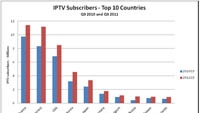Europe beats Asia over IPTV penetration

Europe is still a strong market for IPTV despite approaching saturation in some countries, with rates of deployment actually increasing, according to the Broadband Forum.
This is in defiance of earlier predictions that IPTV growth in Europe would flatten out, with the Broadband Forum now indicating that subscriptions will continue to advance healthily on the back of sustained deployment of FTTx. Given the prohibitive cost of running fiber all the way to individual homes for FTTH, analyst group Point Topic, which compiled the global IPTV survey for the Broadband Forum, is predicting that European Telcos and governments will, over the next few years, focus on FTTx, meaning either Fiber To The Curb (FTTC), or Fiber To The Building (FTTB). With FTTC, and in some cases with FTTB as well, the final delivery to the customer is twisted pair copper using VDSL technology, taking advantage of the shorter distances to increase bit rate, enabling multichannel HD services.
This trend is already well underway, with the number of FTTx homes in Europe increasing by 69 percent over the year from 5.8 million to 9.8 million by the end of Q3 2011. By contrast, the number of European FTTH homes rose just by 28 percent from 2.5 million to 3.2 million.
“The future of Europe, at least for the next five years, is going to be dominated by FTTx,” said Oliver Johnson, CEO at Point Topic. “The cost of full fiber (FTTH) deployment, particularly the last mile, is prohibitive and so the industry and consumers need a stepping stone, which is provided by hybrid solutions such as FTTx. FTTx provides a significant increase in bandwidth and an efficient use of existing infrastructure, and allows the welcome continued amortization of costs.”
Global TV subscriptions reached a new peak of 55 million at the end of the third quarter of 2011 according to the survey, just over 6 percent up on the same period of 2010, with Europe accounting for 23.5 million of these. France was, just, still the leading country on 11.5 million, and surprised the industry with resurgent growth of 16 percent — outstripping the global average. This had the effect of delaying the date China overtakes to become number one, which is happening around now.
While most of Europe witnessed healthy IPTV growth, with Russia entering the world’s top 10 for the first time, the effects of the deep recession was felt in some southern countries of the Eurozone, with Spain falling out of the world’s top 10, and Italy faring worse, with even the number of broadband subscribers declining there.
The professional video industry's #1 source for news, trends and product and tech information. Sign up below.
